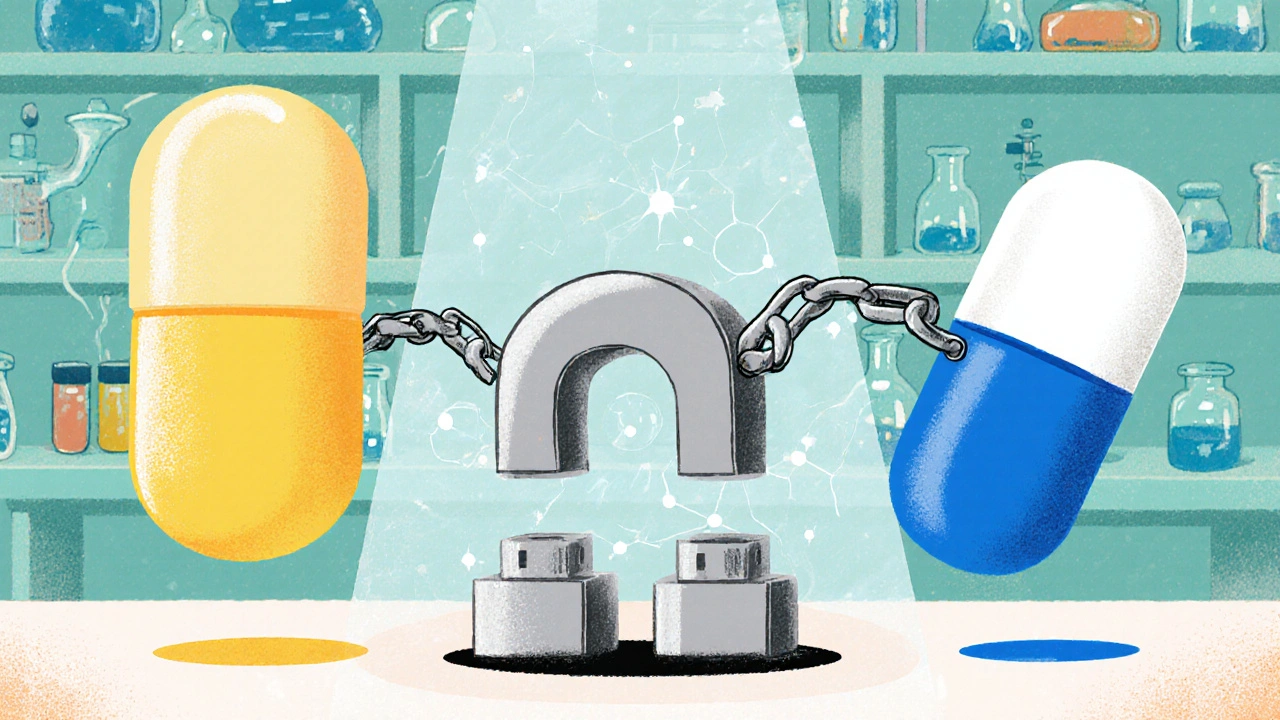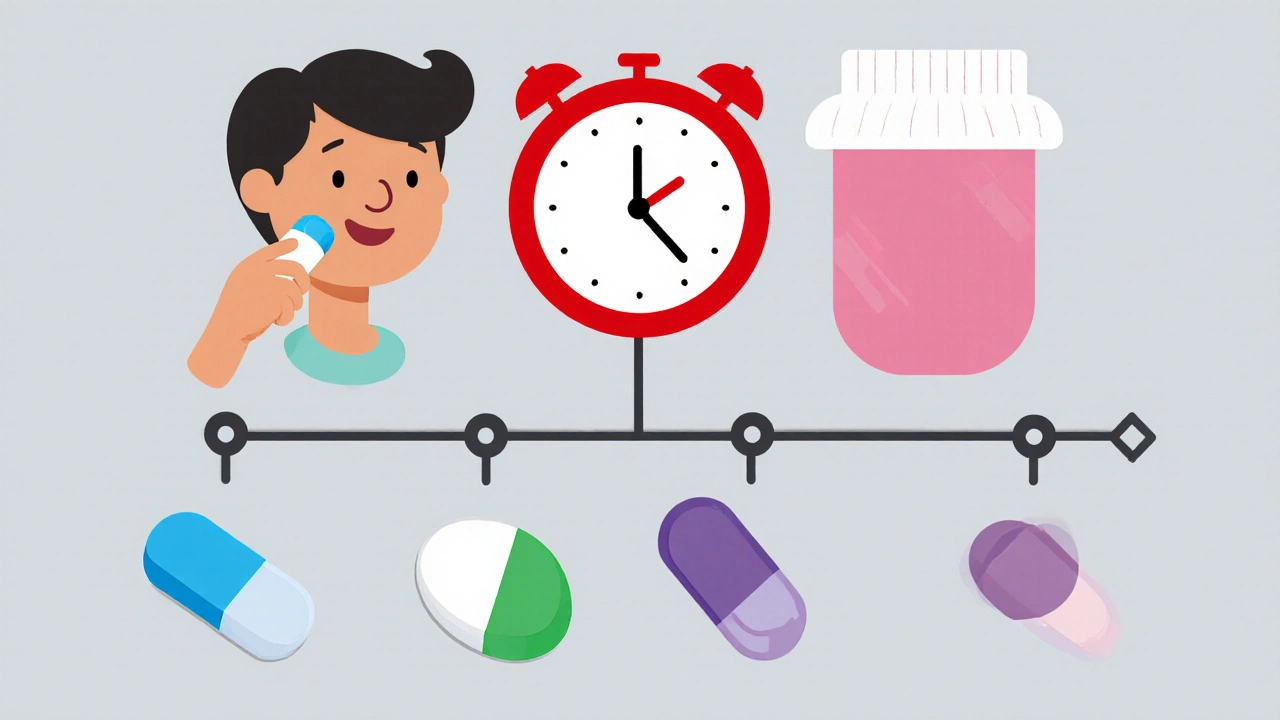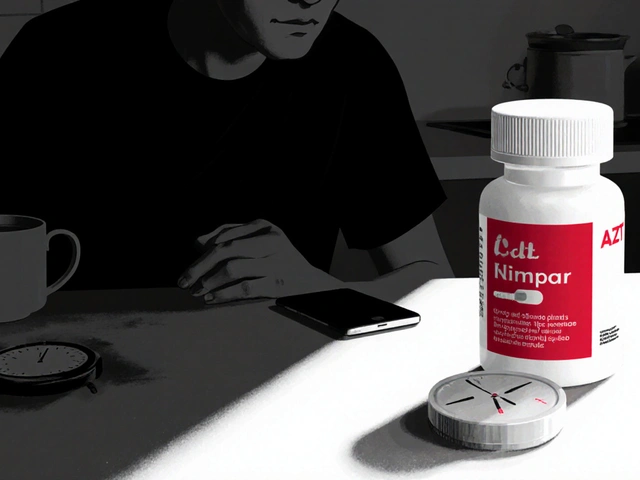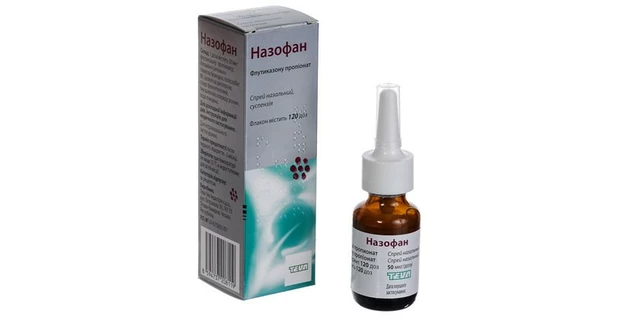
Antacid-Antibiotic Timing Calculator
Select Your Medications
When you pop a cheap antacid for heartburn and then take an antibiotic for an infection, you might think you’re covering all bases. In reality, many over‑the‑counter antacids can sabotage the antibiotic’s ability to work, sometimes by as much as 90%. This article untangles why the clash happens, which drugs are most vulnerable, and what simple timing tricks can keep your treatment on track.
What makes OTC antacids interfere with antibiotics?
OTC antacids are medications that neutralize stomach acid using metal‑based compounds such as aluminum hydroxide, magnesium hydroxide, calcium carbonate, or sodium bicarbonate. They act fast (often within minutes) and are sold in liquid, chewable, or tablet form for heartburn, acid reflux, and dyspepsia relief. While they calm a burning stomach, those metal ions love to bind with certain antibiotics, forming insoluble complexes that the gut can’t absorb.
The chemistry is called chelation. Imagine a magnet (the metal ion) snapping onto a pill molecule (the antibiotic). The resulting “magnet‑pill” stays stuck together, too large to slip through the intestinal wall, so the bloodstream sees less of the drug.
Two factors decide how bad the interaction gets:
- Acid‑neutralizing capacity (ANC): Higher ANC means more metal ions, which means more binding sites.
- pH shift: Raising stomach pH can also impede antibiotics that need an acidic environment to dissolve.
The antacid antibiotic interaction is therefore a pharmacokinetic issue, not a toxic one. The antacid itself isn’t absorbed in any meaningful amount, but it reshapes the environment your antibiotic depends on.
Antibiotics that fall hardest
Research from the 1970s onward has zeroed in on two major families:
- tetracyclines (e.g., tetracycline, doxycycline) - chelation with aluminum and calcium can cut absorption by 70‑90%.
- fluoroquinolones (e.g., ciprofloxacin, levofloxacin) - metal binding drops bioavailability by 40‑75%.
Specific numbers from a 2022 F1000Research study illustrate the range:
- Tetracycline: 80‑90% reduction when taken with an aluminum‑containing antacid.
- Doxycycline: 30‑50% reduction with magnesium‑hydroxide products.
- Ciprofloxacin: falls from ~70% oral bioavailability to under 25% if a calcium carbonate antacid is in the stomach.
- Levofloxacin: loses about a quarter of its absorption with mixed aluminum‑magnesium formulas.
Some beta‑lactams like amoxicillin see a modest 18‑22% dip with aluminum‑magnesium antacids, though data are mixed. In contrast, famotidine (an H2 blocker) and proton pump inhibitors rarely chelate antibiotics because they lack metal ions, making them safer co‑therapies.
Timing is everything - how to separate them
Guidelines from the American Gastroenterological Association (2022) and the NIH’s StatPearls (2023) converge on a simple rule: keep a gap of at least 2‑4 hours between the two. The exact window depends on the antibiotic class:
- Tetracyclines: minimum 2‑hour separation before or after the antacid.
- Fluoroquinolones: aim for 4‑hour separation (often 4‑6 hours is safest).
- Beta‑lactams (e.g., amoxicillin): a 2‑hour gap usually suffices.
Why the difference? Fluoroquinolones bind more tightly to metal ions and have slower gastric emptying, so a longer buffer period lets the drug clear before the antacid floods the stomach with ions.
Practical tip: set an alarm on your phone. Take the antibiotic first, wait the required hours, then reach for the antacid if you still need relief. If your schedule makes that impossible, ask your prescriber about switching to a non‑chelating acid reducer like famotidine for the duration of therapy.

Which antacid formulations cause the biggest problems?
| Antacid Brand / Ingredient | Metal Content (mg per dose) | Typical ANC (mEq) | Average Reduction in Tetracycline Absorption | Average Reduction in Fluoroquinolone Absorption |
|---|---|---|---|---|
| Calcium carbonate (e.g., Tums) | Calcium 200‑800 | 12‑20 | 70‑85% | 50‑70% |
| Aluminum hydroxide + magnesium hydroxide (Maalox, Mylanta) | Aluminum 200, Magnesium 200 | 15‑25 | 80‑90% | 60‑75% |
| Sodium bicarbonate (e.g., Alka‑Seltzer) | Sodium 500‑1000 | 10‑15 | 15‑30% | 10‑20% |
| Magnesium hydroxide alone (Milk of Magnesia) | Magnesium 800‑1200 | 12‑18 | 30‑45% | 20‑35% |
The table shows a clear pattern: the more metal ions, the steeper the drop in antibiotic absorption. Calcium carbonate, while often perceived as “harmless,” still knocks out three‑quarters of the tetracycline dose if taken together.
Alternative acid‑control strategies during antibiotic courses
If you need immediate heartburn relief but can’t wait for a 4‑hour gap, consider these work‑arounds:
- Switch to an H2 blocker: famotidine starts working in 30‑60 minutes and avoids metal chelation.
- Short‑term proton pump inhibitor: omeprazole or similar reduces acid for 24‑48 hours without adding metal ions, though onset is slower (1‑4 hours).
- Use a timed‑release antacid: Newer formulations release neutralizing agents slowly, lowering peak metal concentrations and possibly lessening binding - still experimental but promising.
Whichever route you pick, always run it past a pharmacist or your prescriber. They can verify that the alternative won’t interact with the specific antibiotic you’re on.
Clinical impact - why the timing matters
Improper timing isn’t just a lab curiosity; it translates to real‑world treatment failures. A 2024 University Hospitals case series reported a 37% higher infection‑persistence rate when patients took ciprofloxacin alongside calcium carbonate without spacing. The same analysis linked the mishap to rising antibiotic‑resistance concerns - sub‑therapeutic levels give bacteria a chance to adapt.
Older adults are especially vulnerable. A 2022 consumer survey found only 32% of OTC antacid users were aware of the interaction, yet polypharmacy is common in that age group. Missing the timing window can tip the balance from cure to chronic infection.
On the bright side, education works. Pharmacist‑led counseling that emphasizes the 2‑4‑hour rule cut treatment‑failure rates by 28% in a prospective study. Simple tools like printed timing charts or smartphone reminders have proven effective across primary‑care clinics.
Bottom line checklist for patients and providers
- Identify the antacid’s metal content (look at the label - aluminum, magnesium, calcium are red flags).
- Know which antibiotic you’re on - tetracycline or fluoroquinolone classes need the longest gaps.
- Schedule doses: antibiotic first, wait the recommended hours, then take the antacid.
- If immediate relief is needed, ask for an H2 blocker or PPI instead of a metal‑based antacid.
- Document the timing in your medication list or medication‑management app.
Following these steps keeps the antibiotic at therapeutic levels, preserves its ability to clear the infection, and helps slow the tide of antibiotic resistance.
Frequently Asked Questions
Can I take an antacid with amoxicillin?
Amoxicillin’s absorption can drop 18‑22% with aluminum‑magnesium antacids. The reduction isn’t usually enough to cause failure, but a 2‑hour gap is still recommended to stay safe.
Why do calcium‑based antacids affect antibiotics?
Calcium ions chelate with the molecular structure of tetracyclines and fluoroquinolones, forming insoluble complexes that the gut can’t absorb.
Is it safe to use famotidine while on ciprofloxacin?
Yes. Famotidine lowers stomach acid without adding metal ions, so it doesn’t interfere with ciprofloxacin’s absorption.
What timing should I use with doxycycline?
Space doxycycline at least 2 hours before or 4 hours after any aluminum‑ or magnesium‑based antacid.
Do PPIs like omeprazole interact with antibiotics?
PPIs don’t contain metal ions, so they rarely chelate antibiotics. They can still affect drugs that need an acidic pH, but the risk is much lower than with antacids.
Got more questions? Talk to your pharmacist - they’re the frontline experts for sorting out drug‑interaction timing.




Abhinav B.
October 24, 2025 AT 20:51Don’t mix antacids with antibiotics – just skip the antacid.
Lisa Woodcock
October 30, 2025 AT 15:45Hey folks, just a heads‑up: those over‑the‑counter heartburn pills can really knock the wind out of your antibiotics. I’ve seen it happen a few times, especially with doxycycline and Tums. If you need relief, try spacing them out by a couple of hours or switch to famotidine for a while. It’s a tiny habit change that can save you a lot of trouble down the road.
Stay safe!
Veronica Appleton
November 5, 2025 AT 10:38Quick tip: take your antibiotic first then wait at least two hours before popping an antacid. This works for most tetracyclines and fluoroquinolones and you won’t need a pharmacist on speed‑dial.
Simple as that.
ram kumar
November 11, 2025 AT 05:31Imagine a world where your cure is silently hijacked by a cheap tablet. You swallow that antacid, feeling the burn subside, unaware that the metal ions are forming an invisible shackles around your antibiotic. The drug, which should be marching into your bloodstream, gets stuck in a chemical prison and never makes it to the infection site. Your body, desperate for help, receives only a fraction of the intended dose. Meanwhile, the bacteria receive a sub‑therapeutic level, a perfect invitation to evolve resistance. Doctors will see “treatment failure” and may prescribe a stronger, broader spectrum drug. The cycle repeats, and you end up paying more and risking more side‑effects. This isn’t a hypothetical; studies have shown up to a 90% drop in absorption with certain antacid‑antibiotic combos. The chemistry is simple chelation – metal ions acting like magnets that cling to the antibiotic molecule. The resulting complex is too large to be absorbed through the gut wall. Your stomach’s pH also shifts upward, further sabotaging drugs that need acidity to dissolve. It’s a double whammy: less drug, wrong environment. The good news? Timing tricks can restore the balance. Set a reminder on your phone, take the antibiotic, wait the recommended gap, then treat the heartburn. If you can’t wait, ask for an H2 blocker or a PPI – they don’t contain those pesky metals. Remember, a few hours’ patience now can prevent a whole course of failed therapy later. Stay informed, space them out, and keep your antibiotics effective.
Deborah Galloway
November 17, 2025 AT 00:25Totally agree with the spacing advice above – it saved me when I was on ciprofloxacin for a urinary infection. I set an alarm and kept the antacid for later in the day, and the infection cleared up fast.
Charlie Stillwell
November 22, 2025 AT 19:18Let’s get real – the pharma industry doesn’t want you to know this, but with the right timing you can avoid a 70% bioavailability drop. 📉💊 Use the 4‑hour window for fluoroquinolones and you’ll keep the drug’s potency. No more “antibiotic resistance” buzzwords, just smart dosing! 🚀
krishna chegireddy
November 28, 2025 AT 14:11People keep saying antacids are harmless, but the data says otherwise. I’m skeptical of the mainstream narrative – maybe it’s a ploy to sell more expensive meds. Keep your eyes open and don’t trust everything you read.
Tamara Schäfer
December 4, 2025 AT 09:05Just wanted to add that setting a phone reminder works wonders – I usually set a 2‑hour alarm after taking my doxycycline. It’s an easy habit that saves a lot of hassle later. Hope this helps!
Tamara Tioran-Harrison
December 10, 2025 AT 03:58Oh, brilliant – because everyone has a spare hour to wait between pills. 🙄 Perhaps we should all just abandon antacids entirely. (◔ᴥ◔)